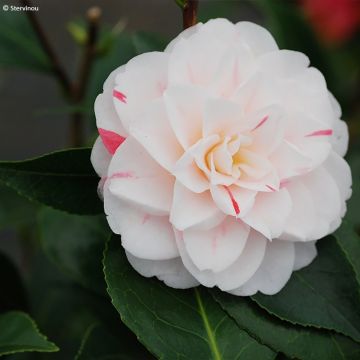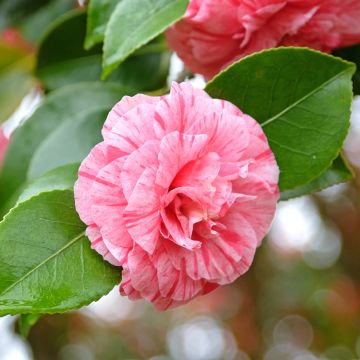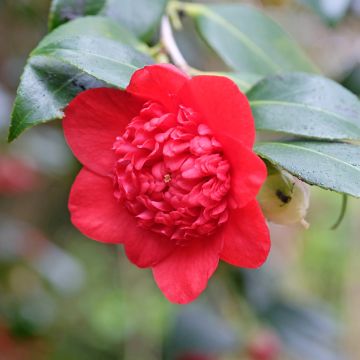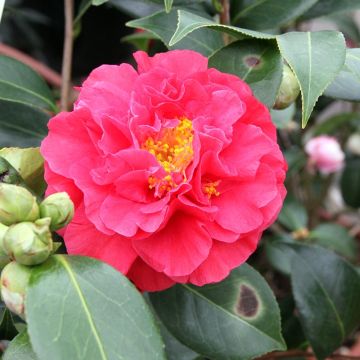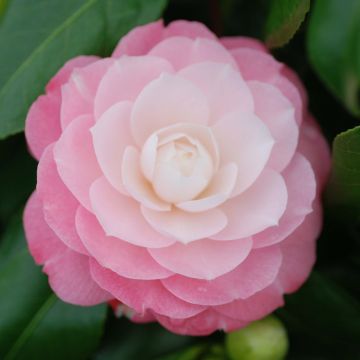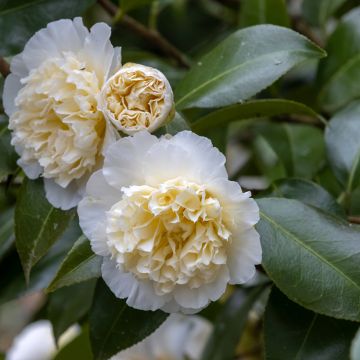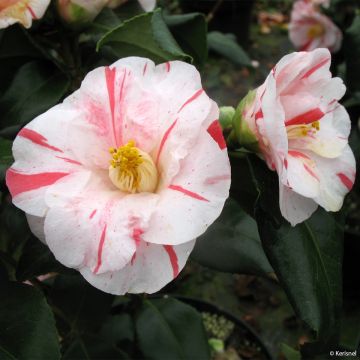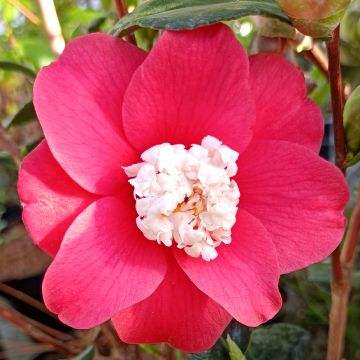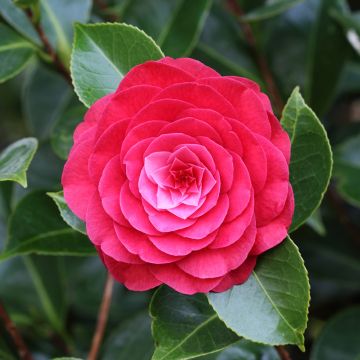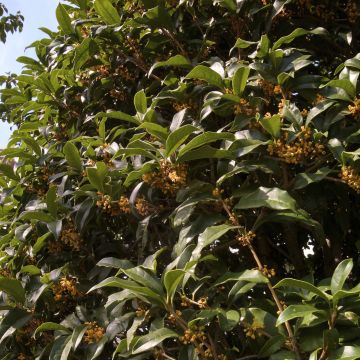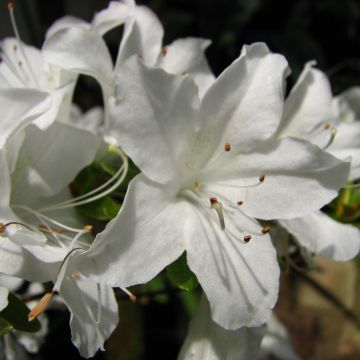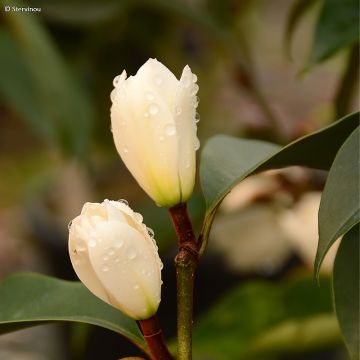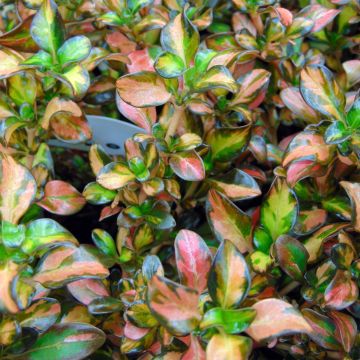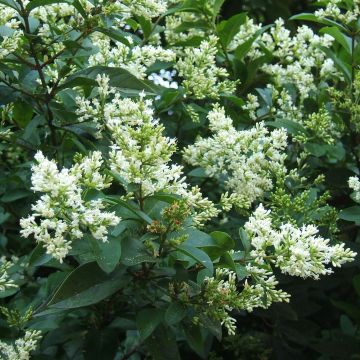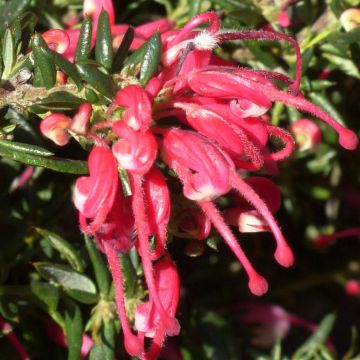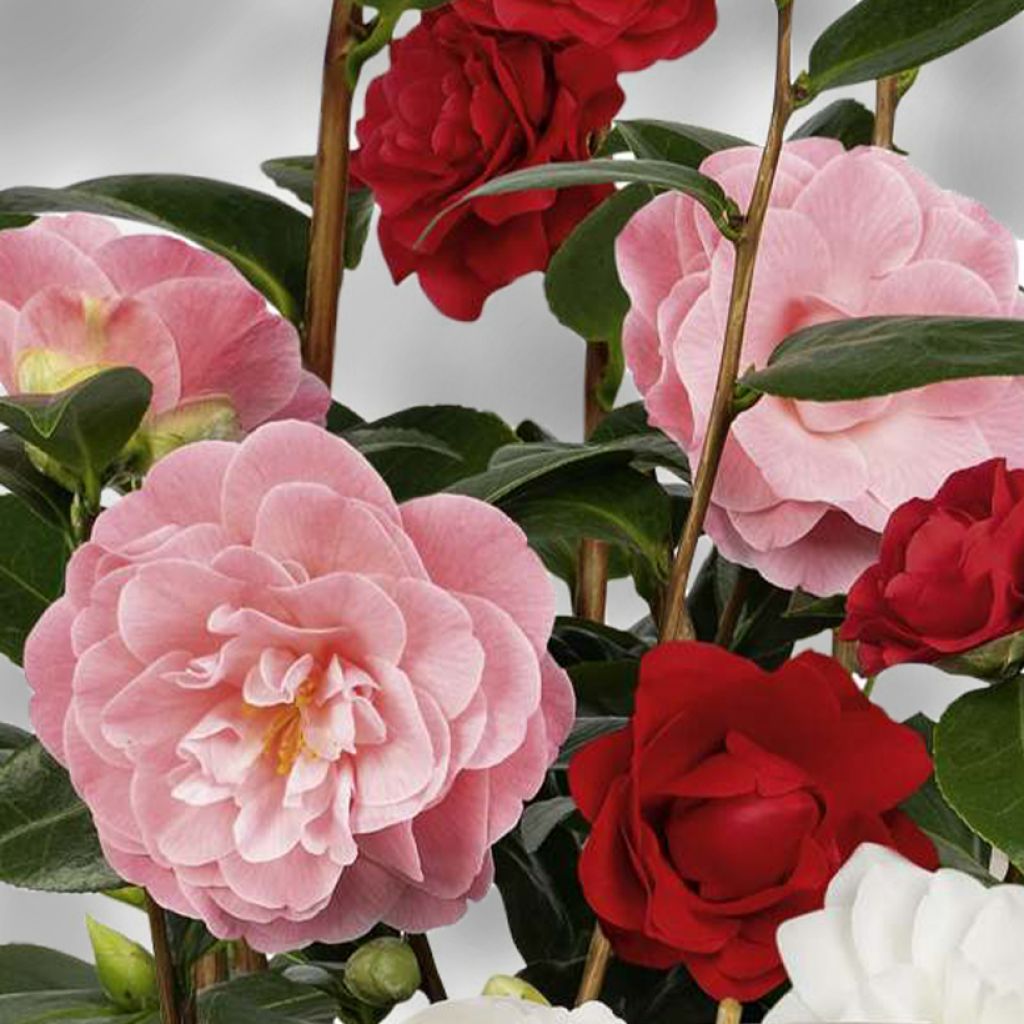

Camellia japonica Three Sisters (Red, Pink White)
Camellia japonica Three Sisters (Red, Pink White)
Camellia japonica Three Sisters ® (Red, Pink White)
Japanese Camellia, Rose of winter
Special offer!
Receive a €20 voucher for any order over €90 (excluding delivery costs, credit notes, and plastic-free options)!
1- Add your favorite plants to your cart.
2- Once you have reached €90, confirm your order (you can even choose the delivery date!).
3- As soon as your order is shipped, you will receive an email containing your voucher code, valid for 3 months (90 days).
Your voucher is unique and can only be used once, for any order with a minimum value of €20, excluding delivery costs.
Can be combined with other current offers, non-divisible and non-refundable.
Home or relay delivery (depending on size and destination)
Schedule delivery date,
and select date in basket
This plant carries a 24 months recovery warranty
More information
We guarantee the quality of our plants for a full growing cycle, and will replace at our expense any plant that fails to recover under normal climatic and planting conditions.
Would this plant suit my garden?
Set up your Plantfit profile →
Description
Camellia japonica 'Three Sisters' is a selection of three Camellia varieties that are as aesthetically pleasing as they are complementary. Grouped together in the same pot, where their dark green glossy foliage blends together, they offer a stunning display in spring when their flower buds open to reveal refined double flowers. The intense red of one variety is matched by the soft pink of another, while the pure white of the third subtly balances this contrast of colours. A beautiful slow-growing composition that can be kept in a container for many years. It can also be planted in the garden, for example near a shaded entrance.
Camellia japonica belongs to the family Theaceae, which includes around ten or twenty genera depending on the classification, the most well-known in ornamental gardening being Camellia, and the most economically important species being Camellia sinensis, which produces tea. Native to Japan, Korea, and China, Camellia japonica forms small trees 6 to 9 metres (19 to 29 feet) high in these regions, producing 5-petaled flowers, usually red in colour. Selected for hundreds of years in Japan, where single flowers are favoured, and in China where they have focused on double flowers, Camellia japonica was introduced to Europe around 1745 and then spread worldwide, sparking the passion of collectors as well as enthusiasts and selective nurserymen. The species now has countless cultivars, with single, semi-double, or highly double flowers, monochrome or bicoloured, to the point where choosing becomes difficult because space is limited!
'Three Sisters' simplifies the choice by offering three particularly decorative varieties in the same pot. Each one offers flowers of a different colour: a vibrant red, a tender pink, and a pure white, which are the three main colours of this species. In March and April this composition is adorned with magnificent double flowers, with a somewhat geometric design, reminiscent of certain old roses or peonies. With a diameter of about 7 to 8 cm (3 in), they enchant the budding spring for several weeks, beautifully decorating a terrace or balcony. The foliage of these varieties consists of medium-sized elliptical leaves with pointed tips, of a beautiful dark green colour with a glossy appearance. This dark background provides a perfect setting for the flowers, and when they have disappeared it continues to be ornamental throughout the rest of the year.
These varieties have been carefully selected for their good resistance to diseases or insects, as well as their compatibility with each other. Comfortable in a coastal climate, Japanese Camellia suffers in drought and heatwaves. It can withstand cold temperatures down to -10°C (14 °F) without any problems, even -15°C, but the flower buds can be damaged in subzero temperatues, so be careful of late frosts.
The 'Three Sisters' Japanese Camellia will be perfect for enhancing a living space such as a terrace or large balcony. You can keep it in reasonable proportions by lightly pruning after flowering once it reaches about 2 m (6 ft) in height. Alternatively plant it in open ground in the garden, where it can then reach its mature size (4 to 5 m (13 to 16 ft) provided you are patient). Plant it in a bed of acid-loving plants, such as Rhododendrons, which offer different colours such as purple or orange, or alongside the colourful and finely cut foliage of Japanese Maples to create a Japanese-style scene. If you keep it on the terrace, play with your options by adding dwarf fruit trees. As well as the aesthetics you can enjoy delicious fruits, and even combine both with the Dwarf Griotella Cherry Tree, which will delight you with its light white flowers, in bloom at the same time as your camellias, and then with its red fruits that are both decorative and succulent!
Report an error about the product description
Camellia japonica Three Sisters (Red, Pink White) in pictures
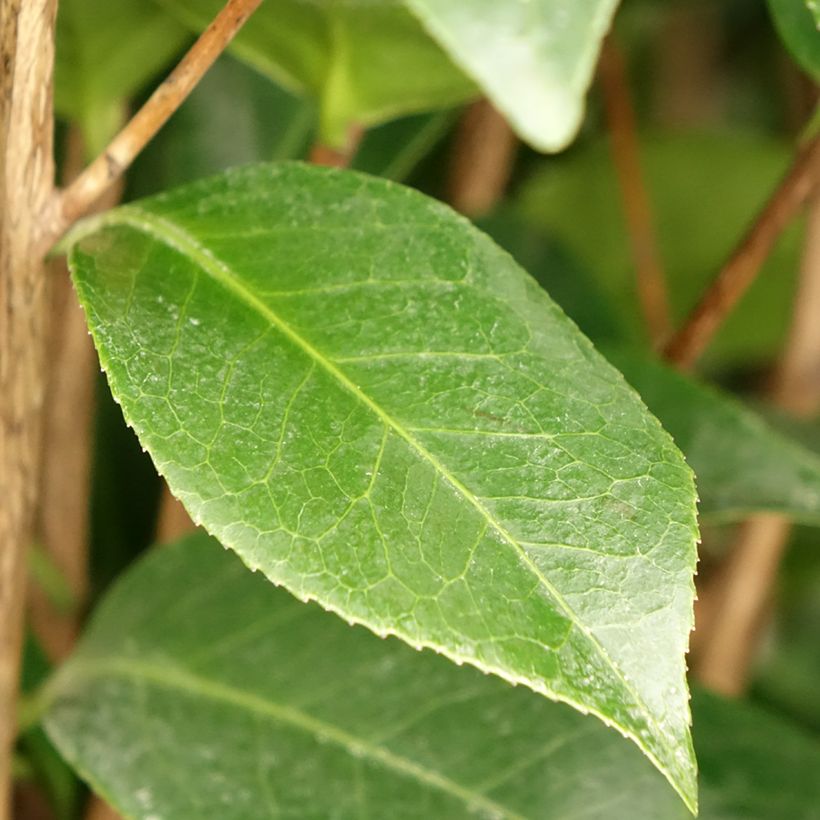

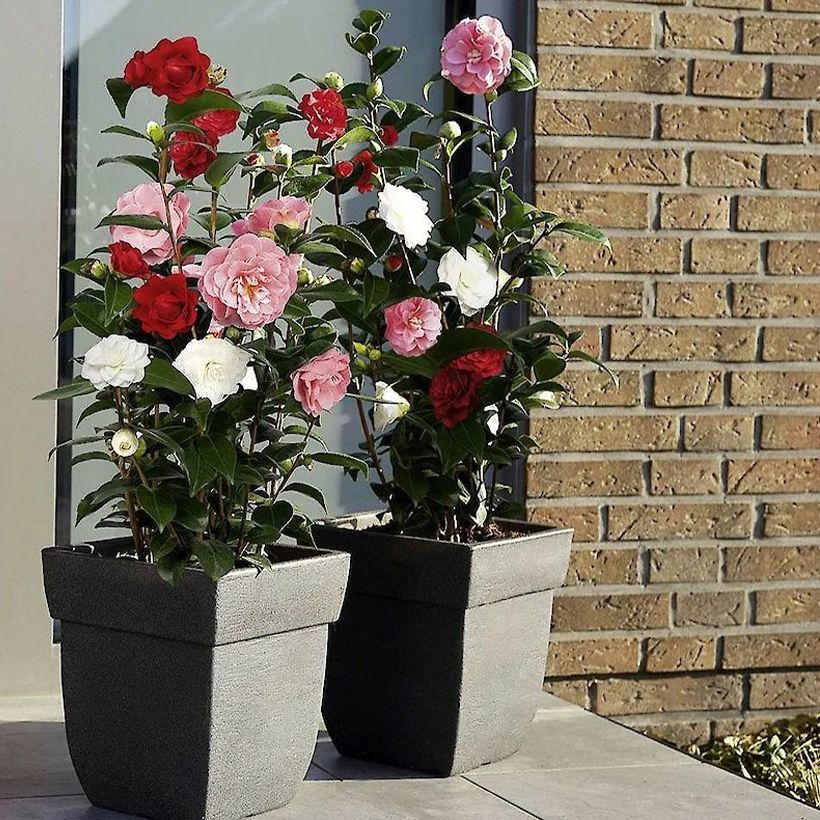

Plant habit
Flowering
Foliage
Botanical data
Camellia
japonica
Three Sisters ® (Red, Pink White)
Theaceae
Japanese Camellia, Rose of winter
Cultivar or hybrid
Other Japanese Camellia
View all →Planting and care
Camellia japonica tolerates the sun in a favourable climate, such as moderately warm coastal regions, but it is in partial shade, protected from the scorching sun and sheltered from strong winds, that it will thrive best. This plant dreads dry and windy atmospheres and does not tolerate heatwaves. Pot cultivation brings a greater risk of dryness than in open ground, since the roots cannot penetrate deeply while the temperature inside the pot can heat up in summer and harm the roots.
It is therefore advisable to install your Three Sisters selection in a thick-walled terracotta pot to ensure thermal insulation, or in a "double skin" plastic container (i.e. with a double wall separated by an air gap). Watering must be regular to prevent the soil from drying out. At the end of winter it may be wise to protect your plants from late frosts with a non-woven fleece cover. Camellia japonica is moderately hardy and can be damaged by temperatures below -10°C (14 °F).
They can also be planted in a moist, humus-rich, acidic, and well-drained soil. Do not plant too deeply: the top of the root ball should be covered with a maximum of 3 cm (1.2 in) of soil. In winter, cover with a 5 to 7 cm (2 to 3 in) thick layer of leaf compost and shredded bark. Beware of late frosts that can damage flowers and buds. During dry periods, water the bush to prevent it dropping its flower buds. It is recommended to plant camellias in autumn to promote good root establishment and better flowering from the first year. Possible diseases include chlorosis caused by excess limestone, brown spots caused by burns on leaves exposed to full sun, sooty mould, scale insects, and weevils.
Pruning is not necessary but if required should be done sparingly just after flowering, before the emergence of new spring shoots. Most camellia hybrids do not recover from hard pruning.
Planting period
Intended location
Care
This item has not been reviewed yet - be the first to leave a review about it.
Similar products
Haven't found what you were looking for?
Hardiness is the lowest winter temperature a plant can endure without suffering serious damage or even dying. However, hardiness is affected by location (a sheltered area, such as a patio), protection (winter cover) and soil type (hardiness is improved by well-drained soil).

Photo Sharing Terms & Conditions
In order to encourage gardeners to interact and share their experiences, Promesse de fleurs offers various media enabling content to be uploaded onto its Site - in particular via the ‘Photo sharing’ module.
The User agrees to refrain from:
- Posting any content that is illegal, prejudicial, insulting, racist, inciteful to hatred, revisionist, contrary to public decency, that infringes on privacy or on the privacy rights of third parties, in particular the publicity rights of persons and goods, intellectual property rights, or the right to privacy.
- Submitting content on behalf of a third party;
- Impersonate the identity of a third party and/or publish any personal information about a third party;
In general, the User undertakes to refrain from any unethical behaviour.
All Content (in particular text, comments, files, images, photos, videos, creative works, etc.), which may be subject to property or intellectual property rights, image or other private rights, shall remain the property of the User, subject to the limited rights granted by the terms of the licence granted by Promesse de fleurs as stated below. Users are at liberty to publish or not to publish such Content on the Site, notably via the ‘Photo Sharing’ facility, and accept that this Content shall be made public and freely accessible, notably on the Internet.
Users further acknowledge, undertake to have ,and guarantee that they hold all necessary rights and permissions to publish such material on the Site, in particular with regard to the legislation in force pertaining to any privacy, property, intellectual property, image, or contractual rights, or rights of any other nature. By publishing such Content on the Site, Users acknowledge accepting full liability as publishers of the Content within the meaning of the law, and grant Promesse de fleurs, free of charge, an inclusive, worldwide licence for the said Content for the entire duration of its publication, including all reproduction, representation, up/downloading, displaying, performing, transmission, and storage rights.
Users also grant permission for their name to be linked to the Content and accept that this link may not always be made available.
By engaging in posting material, Users consent to their Content becoming automatically accessible on the Internet, in particular on other sites and/or blogs and/or web pages of the Promesse de fleurs site, including in particular social pages and the Promesse de fleurs catalogue.
Users may secure the removal of entrusted content free of charge by issuing a simple request via our contact form.
The flowering period indicated on our website applies to countries and regions located in USDA zone 8 (France, the United Kingdom, Ireland, the Netherlands, etc.)
It will vary according to where you live:
- In zones 9 to 10 (Italy, Spain, Greece, etc.), flowering will occur about 2 to 4 weeks earlier.
- In zones 6 to 7 (Germany, Poland, Slovenia, and lower mountainous regions), flowering will be delayed by 2 to 3 weeks.
- In zone 5 (Central Europe, Scandinavia), blooming will be delayed by 3 to 5 weeks.
In temperate climates, pruning of spring-flowering shrubs (forsythia, spireas, etc.) should be done just after flowering.
Pruning of summer-flowering shrubs (Indian Lilac, Perovskia, etc.) can be done in winter or spring.
In cold regions as well as with frost-sensitive plants, avoid pruning too early when severe frosts may still occur.
The planting period indicated on our website applies to countries and regions located in USDA zone 8 (France, United Kingdom, Ireland, Netherlands).
It will vary according to where you live:
- In Mediterranean zones (Marseille, Madrid, Milan, etc.), autumn and winter are the best planting periods.
- In continental zones (Strasbourg, Munich, Vienna, etc.), delay planting by 2 to 3 weeks in spring and bring it forward by 2 to 4 weeks in autumn.
- In mountainous regions (the Alps, Pyrenees, Carpathians, etc.), it is best to plant in late spring (May-June) or late summer (August-September).
The harvesting period indicated on our website applies to countries and regions in USDA zone 8 (France, England, Ireland, the Netherlands).
In colder areas (Scandinavia, Poland, Austria...) fruit and vegetable harvests are likely to be delayed by 3-4 weeks.
In warmer areas (Italy, Spain, Greece, etc.), harvesting will probably take place earlier, depending on weather conditions.
The sowing periods indicated on our website apply to countries and regions within USDA Zone 8 (France, UK, Ireland, Netherlands).
In colder areas (Scandinavia, Poland, Austria...), delay any outdoor sowing by 3-4 weeks, or sow under glass.
In warmer climes (Italy, Spain, Greece, etc.), bring outdoor sowing forward by a few weeks.































